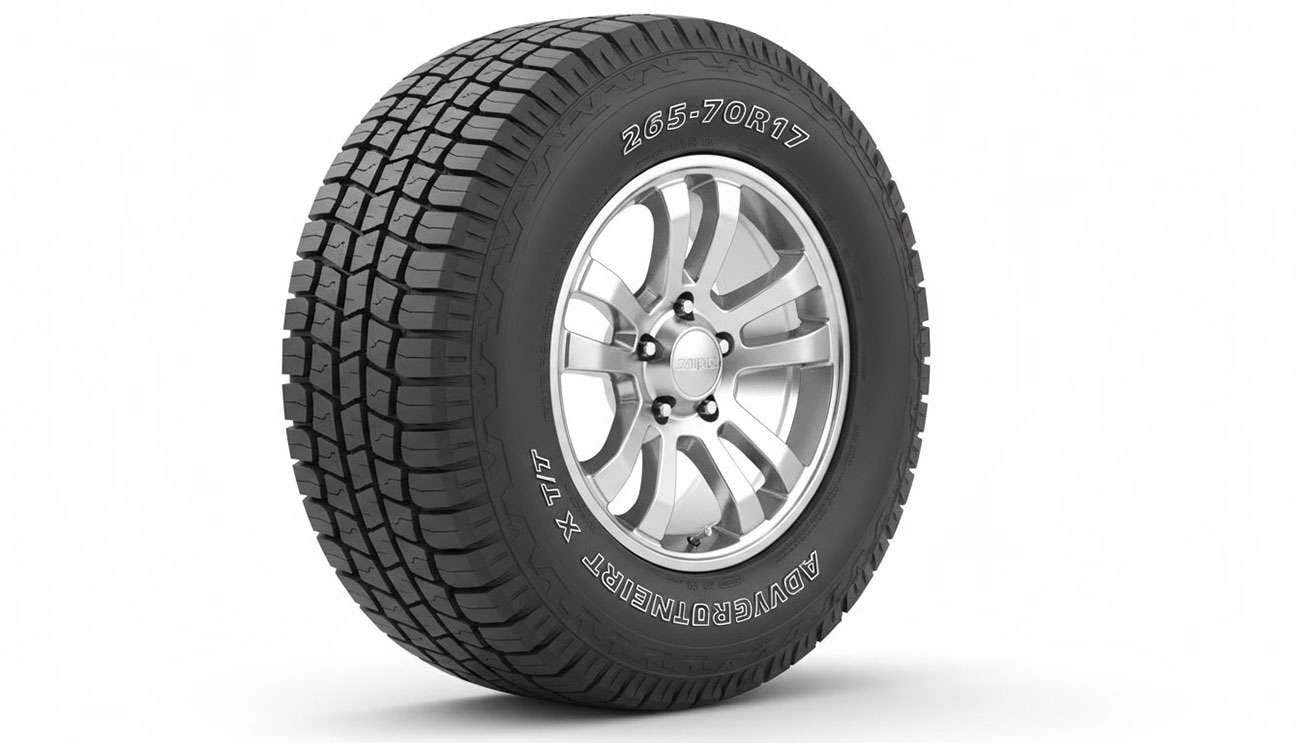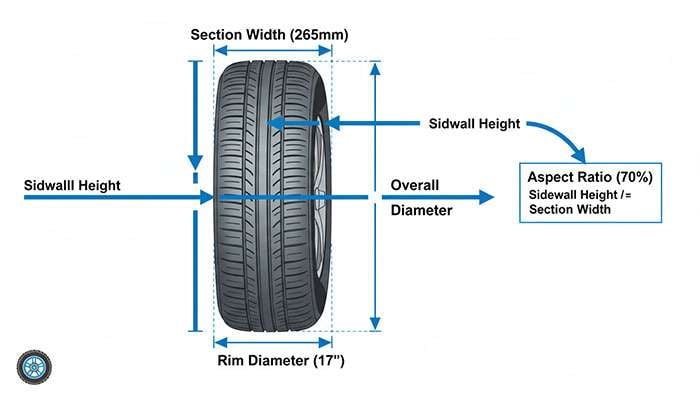
Understanding tire code numbers becomes essential when you need precise measurements for vehicle compatibility and performance. The 265/70R17 tire size ranks among the most popular choices for trucks and SUVs, but knowing the exact dimensions matters more than memorizing the code.
A 265/70R17 tire measures approximately 31.6 inches in diameter (802.8 mm), with a width of 10.4 inches (265 mm) and a sidewall height of 7.3 inches (185.5 mm)[-4]. These tires feature a circumference of about 99.3 inches (2522.07 mm), completing roughly 638 revolutions per mile[-3].
Getting the dimensions right affects everything from ground clearance to speedometer accuracy. Whether you're upgrading your truck, SUV, or off-road vehicle, these measurements determine fitment, performance, and compatibility with your specific setup. The numbers tell the complete story of how these tires will perform on your vehicle.

The 265/70R17 tire code contains specific measurements that determine fitment and performance characteristics. Each number and letter represents a precise specification that affects how your tire performs on your vehicle.
The number 265 represents the tire's width in millimeters, measured from sidewall to sidewall across the tread. Converting to inches gives you approximately 10.4 inches (265mm ÷ 25.4 = 10.4 inches). This width measurement determines your tire's contact patch with the road surface.
Wider tires typically provide better grip and stability during cornering situations. The 265mm width remains consistent across different rim diameters—all tires marked with 265 maintain the same section width of 10.45 inches, regardless of whether they're mounted on 15-inch, 17-inch, or larger wheels.
The aspect ratio of 70 determines your tire's sidewall height as a percentage of the width. This critical measurement affects both comfort and handling characteristics. For the 265/70R17, the calculation works as follows:
265mm × 0.70 = 185.5mm
185.5mm ÷ 25.4 = 7.3 inches
Higher aspect ratios create taller sidewalls that absorb road imperfections better, providing increased comfort and cushioning. Lower aspect ratios result in shorter sidewalls that offer sharper steering response and improved handling precision, though often at the expense of ride comfort.
The "R" designates Radial construction, which has become the standard for modern tire manufacturing. Radial tires use cord layers positioned at 90-degree angles to the direction of travel, combined with steel belts beneath the tread area. Michelin developed this construction method to create stronger tread areas with more flexible sidewalls, delivering improved tread life and better fuel efficiency.
The final number, 17, specifies the wheel diameter in inches. This tells you the tire fits a 17-inch diameter wheel rim. Most 265/70R17 tires work with rim widths between 7-9 inches for passenger vehicles and 7-8.5 inches for LT (Light Truck) applications.
Converting the 265/70R17 tire code reveals the precise measurements that determine fitment and performance on your vehicle.
The overall diameter of a 265/70R17 tire measures 31.6 inches, though some manufacturers' specifications may vary slightly up to 31.7 inches. This total height measurement determines vehicle clearance requirements and affects speedometer calibration. The diameter proves crucial when checking whether the tire will clear your fenders, suspension components, and other vehicle parts without interference.
The section width of a 265/70R17 tire measures 10.4 inches from sidewall to sidewall across the tread. Some manufacturers list slight variations—you might see measurements of 10.43 inches or 10.7 inches depending on specific tire construction and brand. When you need quality 265/70R17 tires with exact specifications, check Performance Plus Tire's selection for options that match your precise requirements.
The sidewall height measures consistently at 7.3 inches across most manufacturers. This dimension comes from the aspect ratio calculation—70% of the 265mm section width. Sidewall height directly impacts ride comfort and handling response, with this 7.3-inch measurement providing a balanced combination of cushioning and control.
A 265/70R17 tire features a circumference of approximately 99.2 inches, with some sources indicating up to 99.5 inches. This circumference determines how many rotations occur per mile of travel. These tires typically complete between 638 and 656 revolutions per mile, with most sources confirming closer to 638 revolutions. Understanding these figures helps calculate speedometer accuracy and gear ratio effects.
For optimal performance and safety, mount 265/70R17 tires on wheels with rim widths between 7 and 9 inches.
When selecting tire sizes, understanding the differences between popular options helps you make the best choice for your vehicle. Here are the key comparisons.
The 285/70R17 provides 0.8 inches more width (11.2 inches vs 10.4 inches) and 1 inch greater diameter (32.7 inches vs 31.6 inches) compared to the 265/70R17. This width difference translates to a wider stance and more aggressive appearance.
The increased size of 285/70R17 tires affects vehicle dynamics. The wider footprint delivers improved traction for off-road applications and enhanced stability during cornering. However, expect reduced fuel economy and increased strain on suspension components. The broader tire also creates more aerodynamic drag, further impacting efficiency.
The 275/70R17 splits the difference between the 265 and 285 options. It measures 10.8 inches wide and 32.2 inches in diameter—about 0.4 inches wider and 0.6 inches taller than the 265/70R17. This moderate increase provides slightly better off-road capability and ground clearance without the dramatic changes of stepping up to the 285 size. The 275 option balances improved capability with minimal impact on fuel consumption.
Many sources classify the 285/70R17 as a 33-inch tire, but the actual diameter measures 32.71 inches—not quite 33 inches. This 0.29-inch difference proves significant when calculating precise clearances or matching speedometer calibration. True 33-inch tires typically require different specifications to achieve the full 33-inch diameter measurement.
No, the 265/70R17 does not qualify as a 33-inch tire. Some retailers might market a 265/70R17 tire in the 33-inch category, but the actual diameter measures 31.6 inches—closer to a 32-inch tire. Real-world measurements from drivers often show these tires running around 31 inches when mounted. The difference matters for clearance calculations and performance expectations.
Tires with 75 aspect ratios stand taller than 70 series options due to the increased sidewall height. A 265/75R17 measures 32.66 inches in diameter compared to 31.61 inches for the 265/70R17—approximately 1.05 inches more height. For quality 265/70R17 options that deliver the performance you need, Performance Plus Tire's selection offers the best brands at competitive prices.

Installing 265/70R17 tires creates more changes than most drivers expect. Ground clearance and appearance improve, but your speedometer accuracy, engine performance, and fuel consumption all shift in ways that matter for daily driving.
Your speedometer will display lower speeds than your actual travel speed after upsizing to 265/70R17 tires. Speedometers calculate speed based on tire revolutions rather than actual distance covered. The larger circumference of approximately 99.2 inches means each revolution covers more ground than stock tires.
At an indicated 65 mph on your speedometer, you're actually traveling about 3-4% faster. This difference becomes significant at highway speeds—when your speedometer shows 75 mph, your true speed reaches around 79 mph. That extra 4 mph could mean the difference between a warning and a speeding ticket in many areas.
These larger tires effectively change your vehicle's final drive ratio. Your engine runs at approximately 1,440 RPM at 60 mph in overdrive, compared to higher RPMs required with smaller stock tires. While lower RPMs sound beneficial, this change reduces low-end torque for acceleration and climbing.
Many owners find their vehicles feel sluggish during acceleration or struggle more on steep grades. For optimal performance while maintaining proper RPM ranges, consider re-gearing your differentials. This modification restores the power delivery characteristics your vehicle was designed to provide.
Expect fuel efficiency to decrease after installing 265/70R17 tires. The primary culprit is increased rotating mass—these tires often weigh about 10 pounds more per corner than stock options. Drivers commonly report a 2-3 mpg decrease that persists regardless of driving conditions.
Winter weather conditions can further reduce fuel economy beyond this baseline decrease. Unlike seasonal fuel economy changes that improve with better weather, the penalty from heavier tires remains constant. This permanent reduction in efficiency represents a real cost that continues mile after mile.
The 265/70R17 tire size offers excellent versatility for trucks and SUVs, but understanding the complete impact helps you make the right choice for your vehicle. These tires deliver solid performance across multiple driving conditions while providing the ground clearance many drivers seek.
The tire code breakdown becomes straightforward once you know what each number represents. This knowledge prevents costly fitment mistakes and ensures compatibility with your vehicle's specifications. Comparing options like the 285/70R17 or 275/70R17 shows how even small changes in width create significant differences in performance and appearance.
Consider the trade-offs before upgrading. Your speedometer will read slower than your actual speed, engine RPM drops at highway speeds, and fuel economy typically decreases by 2-3 mpg. These changes affect daily driving more than many owners expect.
The right tire choice depends on your priorities. If you value off-road capability and aggressive appearance over maximum fuel efficiency, 265/70R17 tires make sense for many applications. However, if fuel economy and precise speedometer readings matter more, smaller sizes might serve you better.
At Performance Plus Tire, we understand that tire selection affects everything from handling to fuel costs. Our expert team can help you evaluate whether 265/70R17 tires match your specific vehicle requirements and driving style. The best tire choice balances your performance needs with practical considerations.
Understanding tire dimensions helps you make informed decisions about vehicle compatibility, performance, and safety when upgrading or replacing tires.
• A 265/70R17 tire measures 31.6 inches in diameter, 10.4 inches wide, with a 7.3-inch sidewall height • The tire code breaks down as: 265mm width, 70% aspect ratio, radial construction, 17-inch rim diameter • Upgrading causes speedometer to read 3-4% slower than actual speed due to increased circumference • Expect 2-3 mpg fuel economy decrease from added rotating mass of larger tires • Engine RPM drops at highway speeds but acceleration capability may decrease without re-gearing
These measurements directly impact vehicle clearance, speedometer accuracy, fuel consumption, and overall performance, making proper sizing crucial for optimal vehicle operation.
A 265/70R17 tire measures approximately 31.6 inches in diameter, 10.4 inches in width, and has a sidewall height of 7.3 inches.
Upgrading to 265/70R17 tires can cause the speedometer to read 3-4% slower than actual speed, reduce engine RPM at highway speeds, and typically decrease fuel economy by 2-3 mpg due to increased rotating mass.
No, 265/70R17 tires are not equivalent to 33-inch tires. They have a diameter of about 31.6 inches, which is closer to 32 inches than 33 inches.
275/70R17 tires are slightly larger than 265/70R17 tires. They are 0.4 inches wider (10.8 inches vs 10.4 inches) and 0.6 inches taller (32.2 inches vs 31.6 inches in diameter).
Before switching to 265/70R17 tires, consider vehicle compatibility, potential impacts on speedometer accuracy, changes in gear ratios and acceleration, effects on fuel economy, and whether the benefits for your driving needs outweigh the drawbacks.